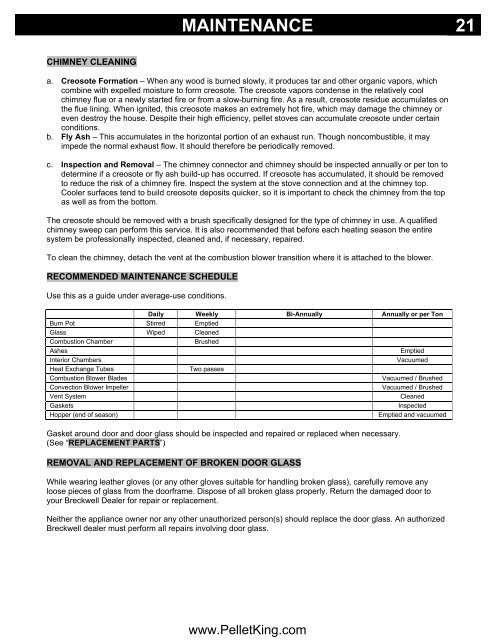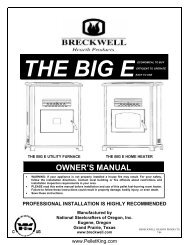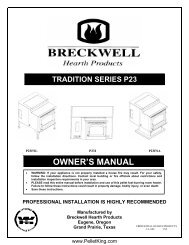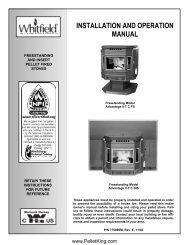P22 2004 Manual - Wood Pellet Stoves
P22 2004 Manual - Wood Pellet Stoves
P22 2004 Manual - Wood Pellet Stoves
You also want an ePaper? Increase the reach of your titles
YUMPU automatically turns print PDFs into web optimized ePapers that Google loves.
MAINTENANCE 21<br />
CHIMNEY CLEANING<br />
a. Creosote Formation – When any wood is burned slowly, it produces tar and other organic vapors, which<br />
combine with expelled moisture to form creosote. The creosote vapors condense in the relatively cool<br />
chimney flue or a newly started fire or from a slow-burning fire. As a result, creosote residue accumulates on<br />
the flue lining. When ignited, this creosote makes an extremely hot fire, which may damage the chimney or<br />
even destroy the house. Despite their high efficiency, pellet stoves can accumulate creosote under certain<br />
conditions.<br />
b. Fly Ash – This accumulates in the horizontal portion of an exhaust run. Though noncombustible, it may<br />
impede the normal exhaust flow. It should therefore be periodically removed.<br />
c. Inspection and Removal – The chimney connector and chimney should be inspected annually or per ton to<br />
determine if a creosote or fly ash build-up has occurred. If creosote has accumulated, it should be removed<br />
to reduce the risk of a chimney fire. Inspect the system at the stove connection and at the chimney top.<br />
Cooler surfaces tend to build creosote deposits quicker, so it is important to check the chimney from the top<br />
as well as from the bottom.<br />
The creosote should be removed with a brush specifically designed for the type of chimney in use. A qualified<br />
chimney sweep can perform this service. It is also recommended that before each heating season the entire<br />
system be professionally inspected, cleaned and, if necessary, repaired.<br />
To clean the chimney, detach the vent at the combustion blower transition where it is attached to the blower.<br />
RECOMMENDED MAINTENANCE SCHEDULE<br />
Use this as a guide under average-use conditions.<br />
Daily Weekly Bi-Annually Annually or per Ton<br />
Burn Pot Stirred Emptied<br />
Glass Wiped Cleaned<br />
Combustion Chamber<br />
Brushed<br />
Ashes<br />
Emptied<br />
Interior Chambers<br />
Vacuumed<br />
Heat Exchange Tubes<br />
Two passes<br />
Combustion Blower Blades<br />
Vacuumed / Brushed<br />
Convection Blower Impeller<br />
Vacuumed / Brushed<br />
Vent System<br />
Cleaned<br />
Gaskets<br />
Inspected<br />
Hopper (end of season)<br />
Emptied and vacuumed<br />
Gasket around door and door glass should be inspected and repaired or replaced when necessary.<br />
(See “REPLACEMENT PARTS”)<br />
REMOVAL AND REPLACEMENT OF BROKEN DOOR GLASS<br />
While wearing leather gloves (or any other gloves suitable for handling broken glass), carefully remove any<br />
loose pieces of glass from the doorframe. Dispose of all broken glass properly. Return the damaged door to<br />
your Breckwell Dealer for repair or replacement.<br />
Neither the appliance owner nor any other unauthorized person(s) should replace the door glass. An authorized<br />
Breckwell dealer must perform all repairs involving door glass.<br />
www.<strong>Pellet</strong>King.com






